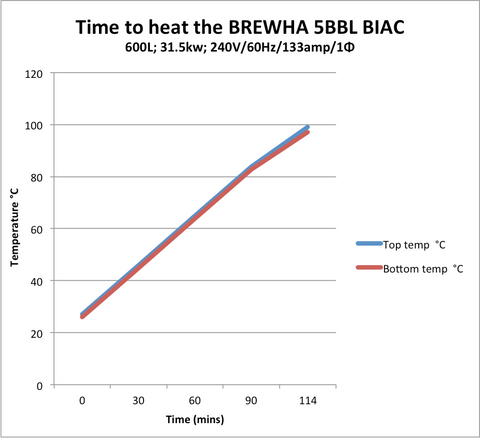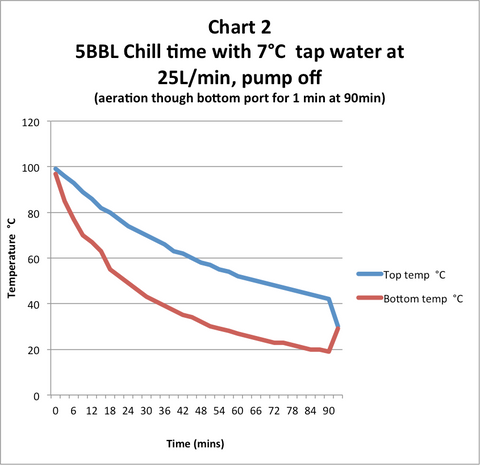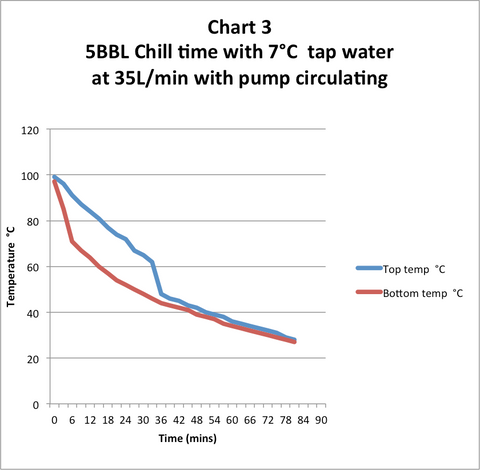Heating and Chilling Methods for the 5BBL BIAC
The BREWHA BIAC complete brewing system is an advanced, innovative brewing system that combines boiling and fermenting into one single vessel. Brew days are therefore simpler and more enjoyable, and the heat of the boil sanitizes the fermenter, giving peace of mind that a microbial infection or residual chemical sanitizers won’t spoil the beer.
When brewing, once the boil is complete, wort is chilled before the yeast is pitched. While yeast won’t be killed unless pitched above 60°C/140°F, if the temperature of the yeast prior to pitching is significantly different from the temperature in the fermenter it can be shocked, resulting in less than optimal fermentation rates.
While other methods can be employed, in the BIAC beer brewing system, hot wort is normally chilled by chillant (ie. water or a water/refrigerant mix) being fed into the wall cavity/jacket of the fermentor. As the chillant rises up through the jacket, it removes heat from the wort through the fermenter wall. This makes it a very sanitary chilling system as the vessel has been completely sanitized by the boil and the wort never leaves the vessel it was boiled in. There is virtually ZERO RISK of contamination from hoses, connections, valves, plate chillers, incompletely sanitized fermenters etc. like in traditional systems where the wort passes from the boil kettle through the chilling apparatus on its way to a fermenter. The one drawback of this method is that due to limited surface area, the chill time can take longer than it would in an appropriately sized counter current plate chiller.
 There has been some discussion online about the benefit of circulating wort inside the BIAC fermentor during knock down/chilling to reduce the chill time from boil to yeast pitching temperature, so we put it to the test in a 5BBL BIAC brewing system. We tested on the 5BBL, since being the second largest system we currently offer, has a lower surface area to volume ratio and therefore represents an approximate average of our commercial systems.
There has been some discussion online about the benefit of circulating wort inside the BIAC fermentor during knock down/chilling to reduce the chill time from boil to yeast pitching temperature, so we put it to the test in a 5BBL BIAC brewing system. We tested on the 5BBL, since being the second largest system we currently offer, has a lower surface area to volume ratio and therefore represents an approximate average of our commercial systems.
 Method:
Method:
The 5BBL conical fermentor was filled with 600L of water, heated to boiling, and the time recorded to see how quickly it would chill down to 27°C/80°F using Vancouver’s municipal water (which on that particular day was 7°C/45°F). The chilling water for the test had a constant flow rate, consistent temperature and the only thing changed was whether or not the pump (Note: a March 5S was used for this test; we now sell the March 7S brewery beer pump exclusively, which is a considerably more powerful pump so breaks the stratification almost right away) was circulating water internally during the chill. The temperature was measured both at the top of the fermentor with a probe hung over the top, and at the fermentor sensor port near the bottom of the fermentor.
 Results:
Results:
The first chart ('Chart 1') shows the chill curve with the pump circulating, and the second chart ('Chart 2') shows it without. The test demonstrated a few things. First, the actual rate of chilling was almost negligible between the two, suggesting that the fermentor is relatively efficient at heat transfer as is, and circulating the wort during chill does not reduce chilling time significantly. Second, if the wort is not circulated during the chill, there is a significant temperature stratification inside the fermentor, with the water/wort at the top of the fermentor being much warmer than the bottom. However, when gas (air) was introduced into the bottom of the fermentor for about a minute (at 90 minutes, much the same as would occur through aeration prior to pitching yeast) the bubbling action inside the fermenter caused by the rising gas bubbles, broke the temperature stratification and neutralized the temperature difference almost immediately.
 Discussion:
Discussion:
One conclusion from this study, is that if a brewer chooses to not circulate during the chill, they should aerate prior to pitching yeast, to agitate the wort and ensure that the temperature sensor shows a true averaged temperature inside the fermentor, not just the temperature of the wort near the bottom. (Choosing not to circulate during chill can be beneficial in that it allows the wort proteins to settle to the bottom of the fermentor where it can be removed prior to aeration.)
While a faster post-boil knock down / chill period is often desired, a longer period does not have negative effects, as long as sanitary conditions are maintained.
There are three main factors to chilling duration -- temperature differential (the greater the differential between chillant and wort the faster the chill), chillant flow rate (a faster flow rate reduces chill time to a certain extent), and surface area (greater surface area leads to reduced chill time). If desired, chilling time can be reduced by reducing the chillant temperature. Since an increased temperature differential reduces chill times, colder chillant reduces chill times (which is why glycol, which freezes at temperatures much below that of water, is often mixed with water to reduce its freezing point and provide a chilling media with lower temperature). Since glycol is expensive and messy to work with, where tap water is warm, using pre-chilled near freezing water is a good solution. Chill times can also be reduced by increasing the rate of flow of chillant (this is really just a corollary of the first method, as by increasing the rate of flow, the chillant has less residence time and therefore prevented from heated as much and has a lower temperature); of course this is only effective to a certain extent, beyond which increasing flow rates has minimal effect.
To test the influence of the first two factors (temperature differential and flow rate), we ran a third test, identical to the first test, with the only variable changed was increasing the flow volume of water from 25L/minute to 35L/minute. As expected, the increased flow rate chilled the water quicker, about 10% faster (see 'Chart 3'). We would expect that this increase follows the law of diminishing returns (increasing the flow rate even further, would not see the same time reduction ratio), just as a reduction of flow volume below 25L/min would not see a linear increase in chill period. From this result we would predict that a lower chillant temperature would show a similar reduction in chill time, so with a reduced but sufficient flow rate, and sub zero chillant temperature, chill times around an hour could be achieved.
Note 1: If municipal water is too warm or a faster chill is desired, tap water can be used for the first 2/3 of the chill, and pre-chilled cold water from a cold water storage tank can be used to finish the chill. So for example, use 15C/60F tap water for 30 minutes at 30L/min (~8gallon/minute) flow rate for 30 minutes, then reduce to 20L/min (~5gallon/minute) for another 30-45 minutes until sensor reads 25C/80F; then switch to 950L/250gallon/8BBL Cold Liquor Tank for example, prechilled overnight with the Lindr Brewery Beer and Wort Chiller to 38F/3C, to bring the wort temperature down to 20C/70F. This is an example for use with the 5BBL brewing system, smaller vessels might require slightly less, and the 7BBL brewing system slightly more (or even a second 950L/250USG/8BBL Cold Liquor Tank).
Note 2: In addition to using the jacket, a plate chiller can be used to help reduce chilling time by increasing surface area. Boiling wort can be cycled through the plate chiller (out the fermenter, through plate chiller and back into the fermenter in a closed-loop manner) during the last few minutes of the boil to sanitize it, then it can be used to help chill the wort (in addition to using the jacket) after boiling is complete. Plate chillers can be purchased from many suppliers, such as the CPE30H from CPE Systems or the T4 from Thermaline.
2 comments
Thank you Brent—revision made.
Just reading the heating and chilling mthods. 5BBL BIAC. Under ‘Discussion’ 3rd line down. The word ‘boil’ should be changed to ‘chill’ ? /Brent